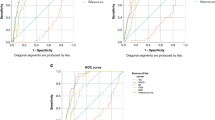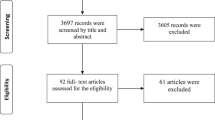Abstract
AIM: The objectives of this study are: (1) to study the relation between body mass index (BMI), percentage-weight-for-height (PWH) and percentage body fat (PBF) in Singaporean Chinese children; (2) to assess the applicability of an international definition of obesity (the International Obesity Task Force (IOTF) BMI) as a screening tool to detect childhood obesity, as compared with the current Singapore population-specific definition using PWH.
METHODS: A total of 623 Chinese children aged 6–11 y (321 males, 302 females) were recruited from a school by proportionate (40%) stratified random sampling. BMI and PWH were calculated from weight and height, while PBF was derived using leg-to-leg bioelectrical impedance analysis. The strength of association among the three indices of obesity was assessed using Spearman's correlation coefficient. Obese children were defined as those above the 95th percentile of PBF in each age–gender-specific group. Sensitivity and specificity of IOTF-BMI cutoff values and PWH cutoff values were compared by testing their ability to correctly identify obese children.
RESULTS: All three indices correlated well with one another (BMI:PWH r=0.83, BMI:PBF r=0.87, PWH:PBF r=0.76). Prevalence of obesity was lower using IOTF-BMI cutoffs (6.9%) than using PWH cutoffs (16.4%). The sensitivity and specificity of IOTF-BMI cutoff values were 75.0 and 96.0%, respectively, with sensitivity differing between boys (83.3%) and girls (66.6%) (P=0.35). In comparison, PWH cutoff values had higher sensitivity (91.6%) but lower specificity (86.6%), with no significant difference between the genders.
CONCLUSION: IOTF-recommended BMI cutoff values had low sensitivity and may underestimate the local prevalence of childhood obesity. For screening purposes, we recommend that population-specific measures rather than international cutoff values be used.
This is a preview of subscription content, access via your institution
Access options
Subscribe to this journal
Receive 12 print issues and online access
$259.00 per year
only $21.58 per issue
Buy this article
- Purchase on Springer Link
- Instant access to full article PDF
Prices may be subject to local taxes which are calculated during checkout
Similar content being viewed by others
References
Must A, Strauss RS . Risks and consequences of childhood and adolescent obesity. Int J Obes Relat Metab Disord 1999; 23: S2–S11.
Deckelbaum RJ, Williams CL . Childhood obesity: the health issue. Obes Res 2001; 9: 239S–243S.
Guo SS, Roche AF, Chumlea WC, Gardner JD, Siervogel RM . The predictive value of childhood body mass index values for overweight at age 35 y. Am J Clin Nutr 1994; 59: 810–819.
Freedman DS, Khan LK, Dietz WH, Srinivasan SR, Berenson GS . Relationship of childhood obesity to coronary heart disease risk factors in adulthood: the Bogalusa Heart Study. Pediatrics 2001; 108: 712–718.
Guillaume M . Defining obesity in childhood: current practice. Am J Clin Nutr 1999; 70: 126S–130S.
Reilly JJ . Assessment of body composition in infants and children. Nutrition 1998; 14: 821–825.
Tyrrell VJ, Richards G, Hofman P, Gillies GF, Robinson E, Cutfield WS . Foot-to-foot bioelectrical impedance analysis: a valuable tool for the measurement of body composition in children. Int J Obes Relat Metab Disord 2001; 25: 273–278.
Sung RY, Lau P, Yu CW, Lam PK, Nelson EA . Measurement of body fat using leg to leg bioimpedance. Arch Dis Child 2001; 85: 263–267.
Ho TF . Eleventh Haridas memorial lecture. Childhood obesity in Singapore primary school children: epidemiological review and anthropometric evaluation. J Singapore Paediatr Soc 1985; 27(Suppl 1): 5–40.
Dietz WH, Bellizzi MC . Introduction: the use of body mass index to assess obesity in children. Am J Clin Nutr 1999; 70: 123S–125S.
Cole TJ, Bellizzi MC, Flegal KM, Dietz WH . Establishing a standard definition for child overweight and obesity worldwide: international survey. BMJ 2000; 320: 1–6.
Reilly JJ, Dorosty AR, Emmett PM, Avon . Longitudinal Study of Pregnancy and Childhood Study Team. Identification of the obese child: adequacy of the body mass index for clinical practice and epidemiology. Int J Obes Relat Metab Disord 2000; 24: 1623–1627.
Deurenberg P, Deurenberg-Yap M . Differences in body-composition assumptions across ethnic groups: practical consequences. Curr Opin Clin Nutr Metab Care 2001; 4: 377–383.
Deurenberg P . Universal cut-off BMI points for obesity are not appropriate. Br J Nutr 2001; 85: 135–136.
Deurenberg-Yap M, Schmidt G, van Staveren WA, Deurenberg P . The paradox of low body mass index and high body fat percentage among Chinese, Malays and Indians in Singapore. Int J Obes Relat Metab Disord 2000; 24: 1011–1017.
Ko GT, Tang J, Chan JC, Sung R, Wu MM, Wai HP, Chen R . Lower BMI cut-off value to define obesity in Hong Kong Chinese: an analysis based on body fat assessment by bioelectrical impedance. Br J Nutr 2001; 85: 239–242.
School Health Services. School Health Service Report 1996.
Jebb SA, Cole TJ, Doman D, Murgatroyd PR, Prentice AM . Evaluation of the novel Tanita body-fat analyser to measure body composition by comparison with a four-compartment model. Br J Nutr 2000; 83: 115–122.
Barlow SE, Dietz WH . Obesity evaluation and treatment: expert committee recommendations. Paediatrics 1998; 102: e29.
Schaefer F, George M, Wuhl E, Scharer K . Body mass index and percentage fat mass in healthy German schoolchildren and adolescents. Int J Obes Relat Metab Disord 1998; 22: 461–469.
Luciano A, Bressan F, Bolognani M, Castellarin A, Zoppi G . Childhood obesity: different definition criteria, different prevalence rate. Minerva Pediatr 2001; 53: 537–541.
Kain J, Uauy R, Vio F, Albala C . Trends in overweight and obesity prevalence in Chilean children: comparison of three definitions. Eur J Clin Nutr 2002; 56: 200–204.
Chinn S, Rona RJ . International definitions of overweight and obesity for children: a lasting solution? Ann Hum Biol 2002; 29: 306–313.
Hennekens CH, Buring JE . Epidemiology in medicine. Boston, MA Little, Brown and Company, 1987.
Barba G, Giacco R, Clemente G, Venezia A, Russo P, Grimaldi C, Siani A . The BRAVO project: screening for childhood obesity in a primary school setting. Nutr Metab Cardiovasc Dis 2001; 11: 103–108.
Acknowledgements
The work described in this paper would not have been possible without the generosity and support of Mr Lee Chin Chuan, member of Hong Wen School's Management Committee 2000, the principal, Mr Ngoh Choon Ho, teachers, staff, pupils and parents of Hong Wen School. We are extremely grateful to all the members of our Community Health Project 2002 group, who have helped us immensely in collecting the information for this study. We thank A/Professor Ng Tze Pin, A/Professor Ho Ting Fei, Dr Lee Yung Seng, A/P Loke Kah Yin and S/N Betty Kek of the Department of Paediatrics, National University Hospital, for their invaluable guidance throughout our project. Our questions on percentage weight for height standards and age-adjusted body mass index were kindly addressed by Dr Uma Rajan, former director of the School Health Service, and Dr Tim J Cole, professor of medical statistics, Department of Epidemiology and Public Health, Institute of Child Health, London.
Author information
Authors and Affiliations
Corresponding author
Rights and permissions
About this article
Cite this article
Fu, W., Lee, H., Ng, C. et al. Screening for childhood obesity: international vs population-specific definitions. Which is more appropriate?. Int J Obes 27, 1121–1126 (2003). https://doi.org/10.1038/sj.ijo.0802385
Received:
Revised:
Accepted:
Published:
Issue Date:
DOI: https://doi.org/10.1038/sj.ijo.0802385
Keywords
This article is cited by
-
Childhood obesity classification systems and cardiometabolic risk factors: a comparison of the Italian, World Health Organization and International Obesity Task Force references
Italian Journal of Pediatrics (2017)
-
Diagnostic accuracy of different body weight and height-based definitions of childhood obesity in identifying overfat among Chinese children and adolescents: a cross-sectional study
BMC Public Health (2015)
-
BMI-based obesity cutoffs and excess adiposity in a Caribbean adolescent population of African origin
European Journal of Clinical Nutrition (2009)
-
Prevalence of Overweight and Obesity in Chinese American Children in New York City
Journal of Immigrant and Minority Health (2009)
-
Evaluation of BMI-based classification of adolescent overweight and obesity: choice of percentage body fat cutoffs exerts a large influence. The COMPASS study
European Journal of Clinical Nutrition (2008)



